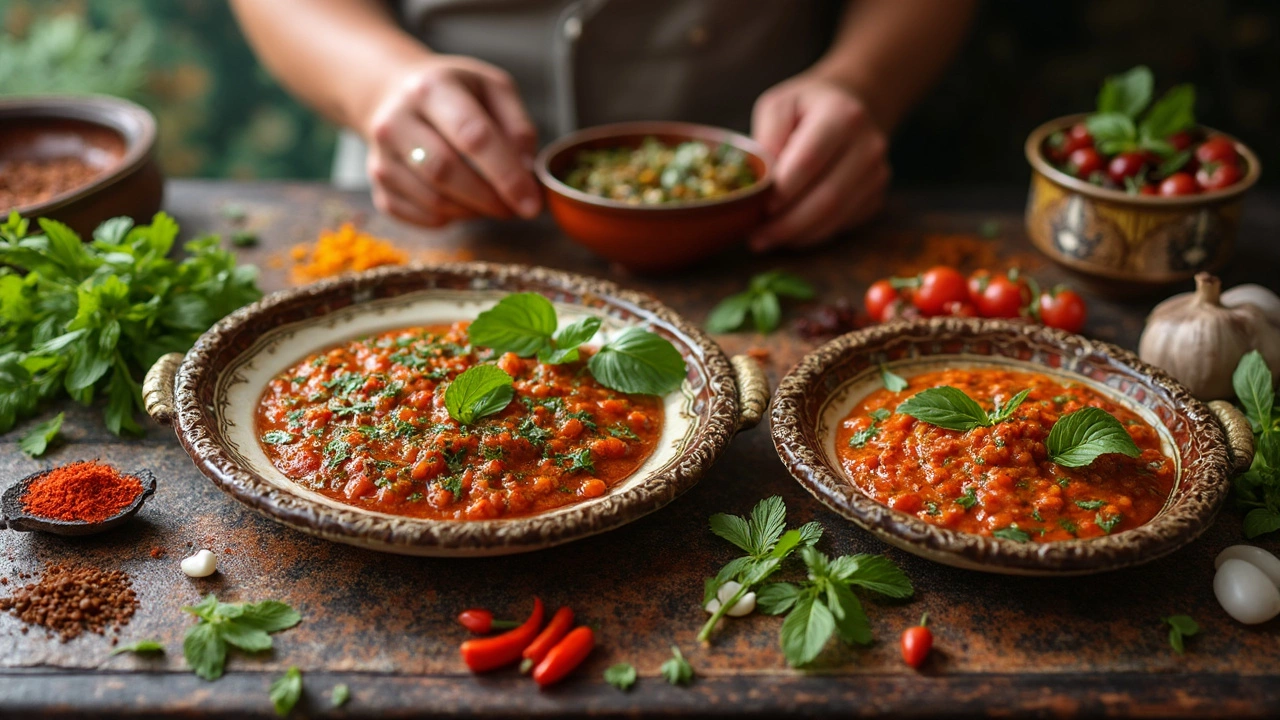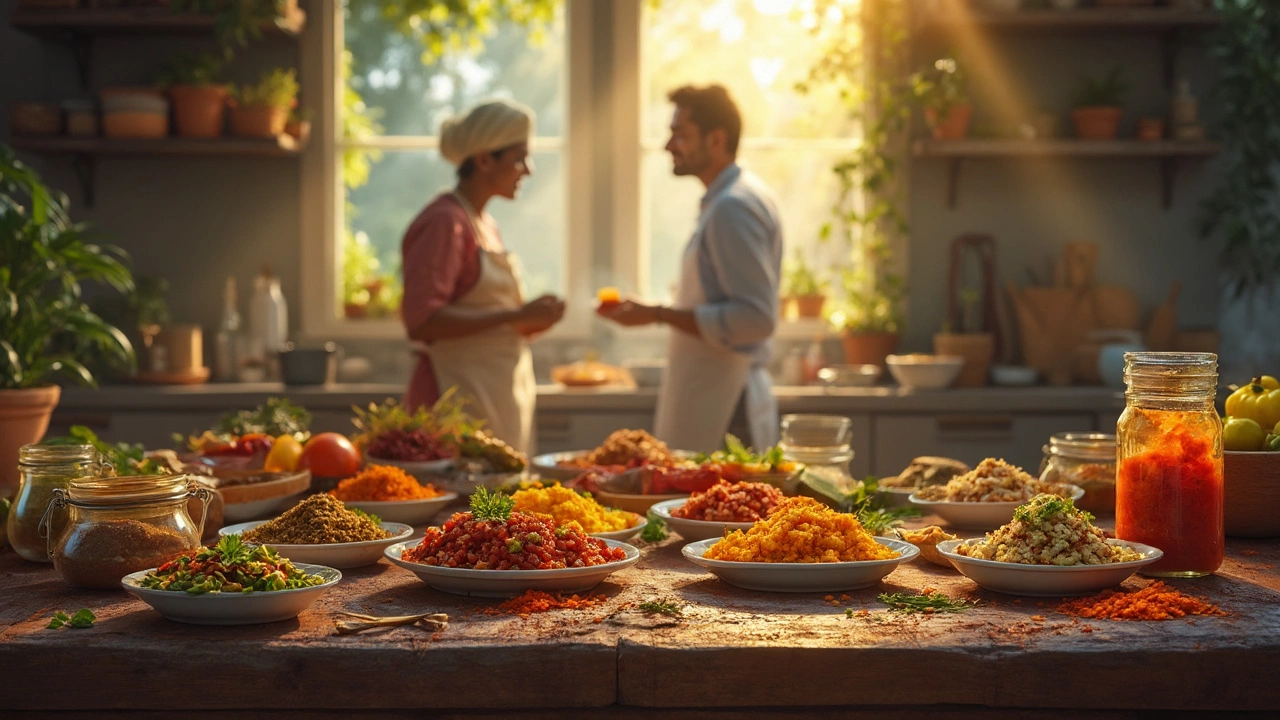Ever wondered how something as exotic as chutney fits into the American culinary landscape? In many ways! Chutney, with its burst of sweet, tangy, and sometimes spicy flavors, adds a whole new layer to dishes. Now, Americans might not call it chutney, but there are condiments like salsa, relish, and even certain types of barbecue sauces that play similar roles in the kitchen.
Imagine slathering salsa over tacos or having some tangy relish on your hotdog. These condiments elevate the taste, offering that bit of oomph you're looking for. Both chutney and its American counterparts are all about making food more exciting. They might not always share the exact ingredients, but the concept is the same—enhancing flavors.
- Chutney: A Flavor Profile
- American Condiments with a Twist
- The Role of Salsa and Relish
- DIY Tips for Mixing Flavors
- Pairing Suggestions
- Cultural Connection through Cuisine
Chutney: A Flavor Profile
Chutney is basically a mix of ingredients that bring together a medley of sweet, tangy, spicy, and sometimes savory notes. Traditionally from Indian cuisine, chutneys come in countless variations, using fruits, vegetables, spices, and herbs. It's like a party in your mouth—a bit unpredictable but always delightful.
The base of a good chutney often includes ingredients like mangos, tamarinds, tomatoes, mint, or coriander leaves. The magic happens when these are mixed with spices such as cumin, mustard seeds, or even chilies for a bit of heat. And then there’s the sweetness, typically coming from sugar or jaggery. If you've ever had a spoonful of mango chutney or mint chutney accompanying a samosa, you know the kind of burst we're talking about.
In modern kitchens, chutneys aren't just staying traditional. People love experimenting, tossing in new ingredients and tweaking the spice levels. Think cranberry chutney for Thanksgiving or an apple chutney to pair with pork chops. Whatever it is, the essence of chutney lies in its ability to complement dishes and elevate the overall meal experience.
Pretty cool, right? Not to mention, it's a great way to stretch the usability of seasonal produce. If you have a bunch of ripe tomatoes or an overload of apples, why not experiment with your own chutney recipe? The combinations are endless.
American Condiments with a Twist
So, what's the deal with American condiments? How do they match up with the exotic allure of chutney? Well, let's take salsa first. Bursting with tomatoes, chili peppers, onions, and cilantro, it's got the tang and spice that you'd find in a good chutney. Salsa isn't just reserved for Mexican dishes; it finds its way into grilled meats, seafood, and even breakfast burritos.
Next up is the humble relish. Its tangy, often sweet nature makes it a popular addition to burgers and hot dogs. Made primarily with chopped pickles, it holds a special place at barbecues. The texture and flavor of relish mirror some types of chutney, especially those that emphasize sweetness.
Martha Stewart, a beloved food innovator, once said, "A good condiment should make you smile, just like a pinch of salt in cookie dough." That's exactly what relish and chutney do to our taste buds.
And what about BBQ sauce? This sweet, smoky, and sometimes vinegary concoction might not be the same as chutney, but it's an American darling. Each regional style, from Kansas City's thick and molasses-like to the vinegar-rich Carolina style, shows how versatile condiments can be.
Here's a fun fact: A survey found that 62% of Americans prefer salsa as their condiment of choice over ketchup! That's some fierce competition in the condiment world.
From sweet to spicy and everything in between, these American variations bring an exciting twist to traditional chutney. Whether it's creating a new dip for chips or slathering it over ribs, their uses are almost endless. You're not just adding flavor; you're adding a story to your meal. Neat, right?
The Role of Salsa and Relish
If you're used to rocking salsa on your nachos or popping some relish on your burger, then you're already dancing in the same flavor party as chutney. Both salsa and relish play a huge role in bringing zestiness and fresh flavors to the table, much like a traditional chutney would do.
Salsa, often made from tomatoes, peppers, onions, and a splash of lime juice, is all about that fresh, vibrant taste. It's a staple in Mexican-American cuisine and perfectly complements tacos and burritos. Salsa matches the fruity and spicy profiles found in many chutneys.
On the other hand, relish typically has a sweet and sharp flavor. It's made from pickled vegetables, like cucumbers, that are finely chopped and mixed with vinegar and sugar. Relish is commonly found in classic American dishes, adding a tangy crunch that echoes the punch chutney brings to Indian fare.
Both these condiments are beloved for their ability to quickly transform a dish. If you’ve ever had burger patties that feel a bit bland, adding relish gives them a lift. Similarly, a dollop of salsa can redefine your experience with boring old tortilla chips.
Whether you’re preparing a Sunday barbecue or a midweek taco night, knowing how to use these chutney cousins can turn the ordinary into a standout meal. You can even get creative and mix them up with your favorite spices or add fruits like mango or pineapple for a personal twist—truly embodying the spirit of what chutney stands for.

DIY Tips for Mixing Flavors
Ready to mix some magic into your meals? Making your very own chutney-inspired condiment is easier than you think and lets you control the flavor balance just how you like it. Plus, it's a fun way to experiment with new combinations and surprise your palate with delightful twists.
Start by choosing a base. The core of any great condiment, inspired by chutney recipes, lies in the balance between sweet and tart. Here’s a handy guide to get you started:
- Fruits: Try apples, mangoes, or even cranberries for that natural sweetness.
- Acids: Vinegar or lemon juice can give you the tangy kick that makes flavors pop.
- Sugar: Add a pinch or two to enhance sweetness and round off the tartness.
Once you've got your base, it's time to spice things up. This is where you can get really creative, borrowing ideas from American condiments like salsa or relish:
- Spices: Think cumin, mustard seeds, or coriander for warmth.
- Peppers: Jalapeños or cayenne can add heat if that's your thing.
- Herbs: Cilantro or mint might just provide that fresh zing you’re after.
Combine your ingredients and let them simmer gently to meld the flavors. This process can take anywhere from 20 minutes to an hour, depending on the texture you’re aiming for.
Wondering what you can pair your newly minted condiment with? Here’s a quick-look table to keep you inspired:
| Dish | Suggested Chutney Pairing |
|---|---|
| Grilled Chicken | Mango-Tamarind |
| Roasted Veggies | Apple-Cinnamon |
| Fish Tacos | Pineapple-Cilantro |
With flavors dialed in just right, your custom creation can now take its place alongside your favorite meals, giving them that extra flair. So, what are you waiting for? Grab those ingredients and get stirring!
Pairing Suggestions
When it comes to pairing chutneys and their American condiment equivalents, it's all about matching flavors and balancing taste. Chutneys are incredibly versatile, and so are their American cousins like salsa and relish. But how do you know what goes well with what? Here's a little guide to get you started.
First up, let's talk about mango chutney, which is sweet and tangy. It's perfect for pairing with grilled meats like chicken or pork chops. The sweetness of the mango complements the smoky flavors of the grill. If you're using salsa, especially a fruity one, try it with fish tacos or as a topping for grilled shrimp. It's a total crowd-pleaser!
Next, there's tomato chutney. With its rich, savory taste, it's a fantastic match for cheeses. Think cheese boards or even just a grilled cheese sandwich. American-style tomato salsa can also work wonders with anything cheesy, like nachos or even as a dip for mozzarella sticks.
For those who love heat, spicy chutneys made with chili peppers pair brilliantly with curries or roasted veggies. The heat sets off meaty flavors really well. Similarly, a hot and spicy BBQ sauce can turn up the flavor of your backyard burgers and steaks. A tip: if you're serving guests, have some plain yogurt or cucumber slices on the side to tame the heat.
If you’re feeling adventurous, mix and match! A pineapple chutney goes well with ham or even on a spicy pizza. Meanwhile, try a sweet pepper relish on a turkey sandwich for an unexpected twist.
| Chutney/Condiment | Pairing Suggestion |
|---|---|
| Mango Chutney | Grilled Chicken, Pork Chops |
| Tomato Chutney | Cheese Boards, Grilled Cheese |
| Spicy Chutney | Curries, Roasted Veggies |
| Pineapple Chutney | Ham, Spicy Pizza |
Remember, tastes are personal, so don't be afraid to experiment. With chutney and sauces that mimic them, the possibilities are kind of endless—and delicious!
Cultural Connection through Cuisine
Food is more than just what we put in our mouths—it's a journey to different worlds right from our kitchen. Take chutney recipes and their American counterparts like salsa and relish. They tell stories of migration, adaptation, and celebration of flavors across the globe.
Think about it: when chutney traveled from India to the rest of the world, it transformed. In America, it morphed subtly into condiments that suit local tastes, like fruity salsas and tangy mustards. This evolution isn't just about flavor; it's about finding a common ground. And trust me, this merger of tastes is as fascinating as it is delicious!
"Food bridges the gap between cultures. While ingredients may differ, the essence of creating something flavorful is universal." - Jessica B. Harris, culinary historian
There's more to these dishes than taste—there are connections to historical trade routes and immigration patterns. Food items like chutney and its equivalents in the U.S. have crossed oceans, bridged communities, and enriched dinner tables worldwide.
Most importantly, such dishes keep evolving. They're perfect for experimenting—mix mango chutney with a dash of hot sauce, or try adding a fruity relish to grilled meats for a sweet and spicy kick.
A cultural connection doesn't just happen on the dinner plate, though. It's in the sharing of recipes, the tweaking of traditional dishes, and finding joy in every bite no matter where you are. So next time you're whipping up a chutney or slathering on some American sauces, remember—you're part of a global culinary conversation.
